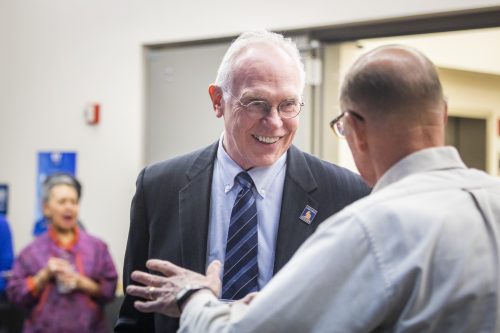Friday Focus: The practical and economic value of research
August 1, 2019

— by Larry Hinzman, vice chancellor for research
These are anxious times for all Alaskans, even more so for university employees. On Tuesday, the Board of Regents voted to develop a plan to consolidate UAF, UAA and UAS into one university. Further, the board directed President Johnsen to develop an approach for “combining duplicative academic colleges and schools, consolidating research institutes, and enhanced integration of community colleges.”
Although this may not be the path forward that some had hoped to see, a decision has been made and directions have been given. It is now incumbent upon us all to work together to ensure the best possible outcome is achieved. While there remains some hope that the Alaska state government will still lessen the total magnitude of the budget cuts to UA, it is painfully obvious that we must absorb a substantial decrease in state funding support.
Our university system remains committed to maintaining the character that made us a great university. We will continue to be a student-centered institution that values shared governance and protects academic freedom. We still possess well-equipped facilities and the top experts in many disciplines. We still work in a unique environment with dozens of important research questions that remain an obstacle to Alaska’s growth and development.
Last week Gov. Dunleavy proposed to eliminate state support for organized research and the UA Museum of the North; however, the Board of Regents expressed genuine concern and support for both. UAF became a strong research university because we invested the funds necessary to grow into a research powerhouse capable of conducting world-class research. From those investments came strong returns. We became a global leader in climate studies, cold regions engineering, space weather, environmental science and all things Arctic. UAF became the principal research entity for Alaska.
Provost Emeritus Susan Henrichs compiled an analysis of how we compare with other research-intensive universities using data from the Higher Education Research and Development Survey, or HERD, which is the primary source of information on R&D expenditures at U.S. colleges and universities. The HERD data reports research for the UA system as a whole and not by the individual university. Nevertheless, in FY17, UAF secured 87% of the federal research funding for the UA system and 86% of the total external research funding. According to the HERD data, UA ranks ninth among the states in the proportion of public university research funding that comes from federal sources; for UA, that was 64% in FY17. UA secured twice the dollar amount of federal grants and contracts per full-time equivalent employee as the national average for public institutions of higher education. Our total grant and contract dollars per employee are 1.7 times the national average.
In most cases, it is not legal for any university to use federal grant money to support the effort required to write a proposal to obtain additional grant money. In all universities, those funds typically come from state support or from an endowment (which at UAF is generally not used to support research). At UAF, organized research receives about $20 million in state support, from which we generate over $100 million in federal grants and contracts — that’s a 1:5 return on investment.
Conversely, if we lose the $20 million in seed money, we will also lose the $100 million in grants and contracts. These funds pay the salaries of many UAF faculty, staff and students, purchase supplies from local businesses, and contract for services from businesses across Alaska. The funds circulate through Alaska’s economy, including paying property taxes and supporting our schools and local businesses.
Most of our graduate students and about 40% of our undergraduate students participate in funded research programs at UAF. Integration of research with academics make our students stronger and our research better.
In addition, UAF research benefits Alaska, addressing challenges that limit growth and development in the state. If we don’t do this work, who will?
There is no basis for the argument that State of Alaska general fund support of research at our universities is unusual when compared with other states. There is certainly no justification to cut research funding when one considers the practical daily value to Alaska or the financial benefits to our economy.
Friday Focus is a column written by a different member of UAF’s leadership team every week.


